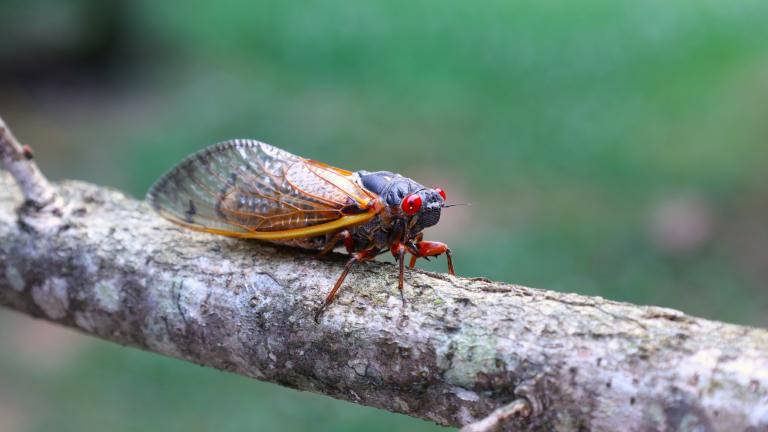 Brood XIII periodical cicada, photographed May 19, 2024, in Illinois. (Patty Wetli / WTTW News)
Brood XIII periodical cicada, photographed May 19, 2024, in Illinois. (Patty Wetli / WTTW News)
Imagine you’re an insect, living underground, and you’re genetically hard-wired to bust out topside every 13 or 17 years. How do you measure time?
Periodical cicadas have an interesting method for keeping track of the calendar, according to scientists.
Because cicadas spend most of their life sucking sap from tree roots, they’re intimately in tune with trees’ cycles. And every year, as trees begin to leaf out in the spring, the flow of water increases from the roots to the greening tips.
“(Cicadas) can detect that,” said Gene Kritsky, professor emeritus of biology and former dean of the School of Behavioral and Natural Sciences at Mount St. Joseph University in Ohio.
In essence, that’s their system of “counting,” or registering that a new year has begun. Exactly how the cicadas add up those years is a whole other question, and one scientists don’t have an answer for, Kritsky noted, beyond an assumption it’s in their DNA.
Here’s where climate change can throw a wrench into things.
An unusually warm January or February can trick trees into leafing out early, and the flow of water to their emerging foliage increases. Cicadas count a year.
Then a cold snap hits and trees halt their process, and the flow decreases. When actual spring arrives and trees leaf out for real, cicadas count a second year.
For reasons scientists don’t understand, cicadas’ math goes haywire in these instances and their emergence accelerates by four years.
Kritsky witnessed this on his home turf of Cincinnati, when Brood X cicadas came out in 2000, ahead of their scheduled 2004 appearance. They were, in effect, now 13-year cicadas, having last emerged in 1987.
Would they continue on a 13-year cycle or revert to 17?
“We waited,” he said.
In 2013, only a few hundred came out. Four years later, in 2017, they emerged by the thousands — so still 17-year cicadas, but no longer in sync with their original Brood X cohort (which turned out en masse in 2021).
“We now have seen evidence that these off-cycle emergences can form reproducing populations, which would be a new brood,” said Kritsky.
In the Chicago area, large numbers of Brood XIII (the 17-year cicadas currently swarming northern Illinois) jumped the gun in 2020, enough to overwhelm predators.
“They sang, they mated, they laid eggs, and those eggs hatched,” Kritsky said, “and that is the first step in forming a new brood.”
Mark Hurley, environmental educator with the Lake County forest preserves, witnessed the 2020 acceleration.
They were in parts of Wilmette, Winnetka and the southeast corner of Lake County, Hurley said.
Will we see them again in 2033 or 2037? The clock is ticking — but which clock?
Contact Patty Wetli: @pattywetli | (773) 509-5623 | [email protected]








